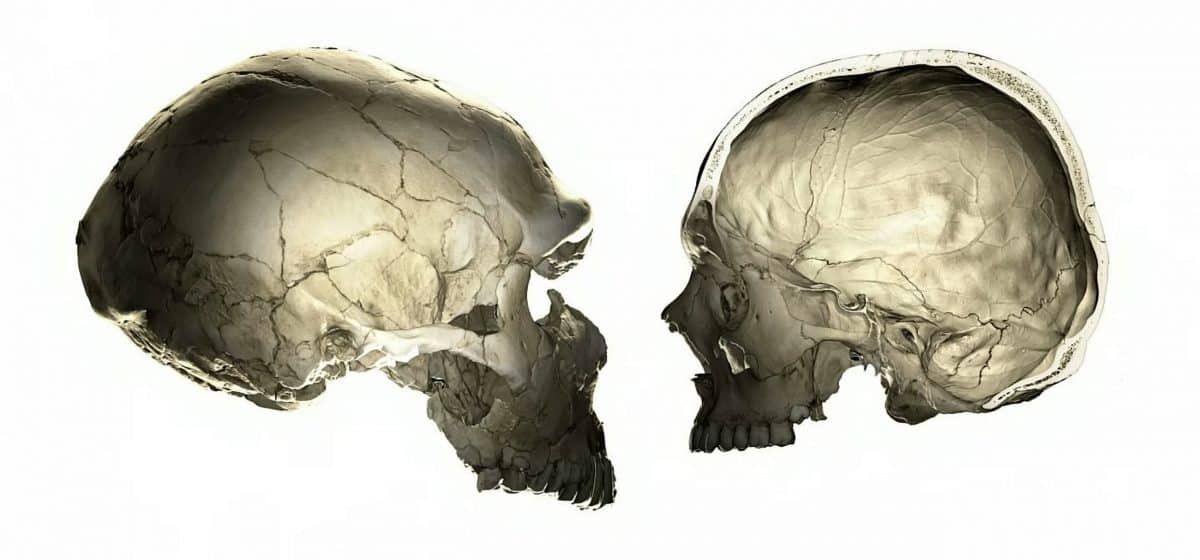
Interbreeding with Neanderthals thousands of years ago has left us with flatter heads, according to new research.
Our skulls are also slightly longer than they should be – a legacy of sex with our primitive cousins.
The traits have been identified in people of European descent whose ancestors fraternised with different human groups.
It has been likened to Middle Earth in JRR Tolkien’s The Lord of the Rings which sees mythical species such as dwarves and elves living side-by-side.
Now scientists have shown for the first time that the results can be seen today – although you have to look pretty close.
Dr Philipp Gunz, of the Max Planck Institute for Evolutionary Anthropology, Leipzig, Germany, said: “I don’t think you would see it with your naked eye. These are not people that would look Neanderthal-like.”
His team took advantage of the fact living Europeans carry rare fragments of Neanderthal DNA buried in their genomes.
Dr Gunz said this is a result of their ancestors interbreeding with our closest extinct relatives – and the effect can be seen in more oblong brains and skulls.
In modern humans these are relatively round or globular – unlike the elongated versions typical of most primates.
But the study found those who carry particular Neanderthal mutations have slightly less rounded heads.
The finding published in Current Biology also sheds light on the evolution of the human brain.
Dr Gunz said: “We captured subtle variations in skull shape that likely reflect changes in the volume and connectivity of certain brain areas.”
They were detected across nearly 4,500 MRI brain scans of Europeans MRI. Analysis of Neanderthal DNA then found they affect the expression of two genes.
Known as UBR4 and PHLPP1, they make the brains of some modern humans slightly less round.
The former is linked with the generation of neurons and the latter fuels myelin – a fatty insulating sheath that protects nerve cells.
Senior author Prof Simon Fisher, a neurogeneticist at the Max Planck Institute for Psycholinguistics Nijmegen, the Netherlands, said: “The effects of the Neanderthal gene variants are small – you would not be able to see them in a person’s head shape when you meet them.”
The Neanderthal DNA had the strongest effects on brain structures known as the putamen and the cerebellum, said the researchers.
These are key to the preparation, learning and coordination of movements. The putamen is part of the basal ganglia which is linked to memory, attention, planning, learning, speech and language.
Prof Fisher said: “We know from other studies completely disrupting UBR4 or PHLPP1 can have major consequences for brain development.
“Here we found – in carriers of the relevant Neanderthal fragment – UBR4 is slightly down-regulated in the putamen.
“For carriers of the Neandertal PHLPP1 fragment, gene expression is slightly higher in the cerebellum, which would be predicted to have a dampening effect on cerebellar myelination.”
The researchers stress the effects of carrying these rare Neanderthal fragments are only detectable in a very large sample size.
Prof Fisher said: “The Neanderthal variants lead to small changes in gene activity and only push people slightly towards a less globular brain shape.
“This is just our first glimpse of the molecular underpinnings of this characteristic, which is likely to involve many other genes.”
The researchers are preparing to scale up their approach and apply it to tens of thousands of people.
That will enable them to carry out a fully genome-wide screen to reveal additional genes associated with head roundness and other features.
Added Prof Fisher: “The interdisciplinary approach that we developed for this study could be applied more broadly to unresolved questions about human brain evolution.”
Many Europeans alive today have up to 2 per cent of Neanderthal DNA scattered around their genomes.
Up to around 40,000 years ago when the Neanderthals died out there were at least three different forms of humans roaming the planet – including a mysterious group called the Denisovans.
Scientists believe there are still unknown human lineages that form a Lord of the Rings style family tree where multiple hominid populations co-existed simultaneously.
by Mark Waghorn